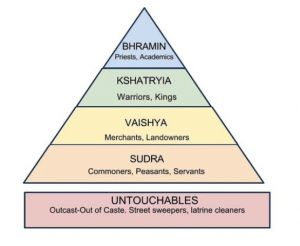THE CONTEXT: The two reports – Global Multidimensional Poverty Index (GMPI), 2021 and the All India Debt and Investment Survey (AIDIS), 2019 revealed the high incidence of poverty among the Scheduled Tribe (ST), Scheduled Caste (SC), and Other Backward Class (OBC) segments. In this article, we will look at caste from an economic perspective and see how poverty and wealth both have a caste bias.

FINDINGS OF THE REPORTS
GLOBAL MULTIDIMENSIONAL POVERTY INDEX (GMPI), 2021:
- Five of the six people living in multidimensional poverty in India are from disadvantaged tribes and castes.
- Poverty levels were highest among the STs(50.6%), followed by SCs (33.3%) and OBCs (27.2%).
- The poverty level among the other castes (those apart from the SCs, STs, and OBCs) was the lowest at 15.6%.
- Poverty levels among the STs were more than thrice that of the other advantaged communities, while the poverty of SCs and OBCs was almost double their levels.
ALL INDIA DEBT AND INVESTMENT SURVEY (AIDIS) 2019:
- In the rural areas :
- The ST and SC households were the most disadvantaged. Their average assets of around 9 lakh each were just a little more than half the average assets of 16 lakh for the rural households as a whole.
- The average assets of STand SC households were only around one-third of the average assets of other households. This group includes all communities other than STs, SCs, and OBCs.
- The average household assets held by the OBCs in rural areas were around `16 lakh, which was similar to the average assets of the rural households in general but less than two-thirds of the average household wealth of the others.
- In Urban Areas :
- The average household wealth of SC was 13 lakh, which was about half that of the 27 lakh averaged by the urban households in general and around two-thirds of the average household assets of 40 lakh.
- The average assets of 19 lakh held by the ST households and 21 lakh held by the OBC households in urban areas were around three-fourths of the average assets of the total urban population and just about half of the other social groups.
REASON BEHIND THE ECONOMIC DEPRIVATIONS BASED ON CASTE
- Market Discrimination: As per a study by Thorat and Katherine in 2009, they showed empirical evidence of market discrimination of the scheduled castes in employment, wages, the purchase of input, and the sale of output by farmers and entrepreneurs.
- Non-market discrimination: The same study highlighted discrimination in non-market institutions in education, health services, and food from the schools, primary health Centres, and fair price shops.
- Control of Wealth: In 2013, almost 45% of the only 7% of coue country wealthy’s wealth was owned by high castes, which exceeded their population share of 21%. SC owner.
Convergence between upper and lower castes in education and jobs
- For centuries, the lower castes have remained locked in unskilled, low-paying occupations in the traditional economy.
- Affirmative action by the state has led to convergence between upper and lower castes in education and jobs.
- Particular castes found particular niches in the urban labour market, and once networks in the city were established, they supported the movement of fresh migrants from the hinterland, often over the course of many generations. By this, they empowered their castes.
- Harish Damodaran’s fascinating book on Indian entrepreneurs documents the movement of castes from agriculture and administrative occupations into business in recent decades.
THE WAY FORWARD
- Policy Innovation: Policies need to be updated and adapted to the realities of the caste in India. They need to cater to the discriminations in the system and thus make it mandatory for all bodies to have a mix of all caste and classes.
- Fighting Non-market discriminations: There are non-market discriminations in the education and health sector. These need to be eliminated with a strong legal hand so as to ensure the creation of an egalitarian society.
- Regulatory Body: A body needs to be created so as to keep a check on economic deprivations based on caste. Any such discrimination needs to be punished under SC&ST Act.
THE CONCLUSION: The recent studies have shown both the continuation of the caste system in India, even in the economic aspect, while other studies have shown convergence between upper and lower castes in education and jobs. This shows that while convergence has started, caste-based discrimination still holds ground in the Indian economic arena. Strong policy interventions are needed to counter it for the creation of an egalitarian society.
Spread the Word
